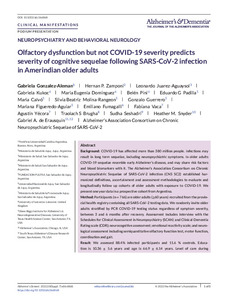Por favor, use este identificador para citar o enlazar este ítem:
https://repositorio.uca.edu.ar/handle/123456789/16493| Título: | Olfactory dysfunction but not COVID-19 severity predicts severity of cognitive sequelae following SARS-CoV-2 infection in Amerindian older adults | Autor: | Gonzalez Aleman, Gabriela Zamponi, Hernan P. Juarez Aguaysol, Leonardo Kukoc, Gabriela Domínguez, María Eugenia Pini, Belén Padilla, Eduardo G. Calvó, María Molina Rangeo, Silvia Beatriz Guerrero, Gonzalo Figueredo Aguiar, Mariana Fumagalli, Emiliano Vaca, Fabiana Yécora, Agustín Brugha, Traolach S. Seshadri, Sudha Snyder, Heather M. Erausquin, Gabriel A. de |
Palabras clave: | COVID-19; ADULTOS MAYORES; ENFERMEDAD DE ALZHEIMER; DISFUNCION OLFATORIA | Fecha de publicación: | 2022 | Editorial: | Alzheimer’s Association Wiley |
Cita: | Gonzalez Aleman, G. et al. Olfactory dysfunction but not COVID-19 severity predicts severity of cognitive sequelae following SARS-CoV-2 infection in Amerindian older adults [en línea]. Alzheimers Dement. 2022, 18 (7). doi: 10.1002/alz.066868. Disponible en: https://repositorio.uca.edu.ar/handle/123456789/16493 | Resumen: | Abstract Background: COVID-19 has affected more than 380 million people. Infections may result in long term sequelae, including neuropsychiatric symptoms. In older adults COVID-19 sequelae resemble early Alzheimer’s disease, and may share risk factors and blood biomarkers with it. The Alzheimer’s Association Consortium on Chronic Neuropsychiatric Sequelae of SARS-CoV-2 infection (CNS SC2) established harmonized definitions, ascertainment and assessment methodologies to evaluate and longitudinally follow up cohorts of older adults with exposure to COVID-19. We present one year data in a prospective cohort from Argentina. Method: Participants (n = 766) are older adults (≥60 years) recruited from the provincial health registry containing all SARS-CoV-2 testing data. We randomly invite older adults stratified by PCR COVID-19 testing status regardless of symptom severity, between 3 and 6 months after recovery. Assessment includes interview with the Schedules for Clinical Assessment in Neuropsychiatry (SCAN) and Clinical Dementia Rating scale (CDR); neurocognitive assessment; emotional reactivity scale; and neurological assessment including semiquantitative olfactory function test, motor function, coordination and gait. Result: We assessed 88.4% infected participants and 11.6 % controls. Education is 10.36 ± 5.6 years and age is 66.9 ± 6.14 years. Level of care during COVID-19 is described in Figure 1. Normalized cognitive Z-scores categorize the cohort in 3 groups with decreased performance compared to normal cognition: memory only impairment (Single-domain,11.7%); impairment in attention+executive function without memory impairment (Two-domain, 8.3%); and multiple domain impairment (Multiple domain,11.6%). Logistic regression showed that severity of anosmia, but not clinical status, significantly predicts cognitive impairment. No controls had olfactory dysfunction. Cognitive impairment is defined as Z-scores below (- 2) (Table 1). Clinical assessment with SCAN revealed functional memory impairment in two thirds of infected patients (CDR ≥ 1), which was severe in half of them. Phone-based follow up at 1 year revealed high adherence (4 participants declined). Five were deceased at follow up. Rates of re-infection (between 10 and 23%) were not affected by the vaccination schedule (Table 2). Conclusion: The longitudinal cohort had very high adherence. Persistent cognitive and functional impairment after SARS-CoV-2 infection is predicted by persistent anosmia but not by the severity of the initial COVID-19 disease. | Cobertura Espacial: | Argentina | URI: | https://repositorio.uca.edu.ar/handle/123456789/16493 | ISSN: | 1552-5279 | Disciplina: | PSICOLOGIA | DOI: | 10.1002/alz.066868 | Derechos: | Acceso abierto | Fuente: | Alzheimers Dement Vol.18, No.7, 2022 |
| Aparece en las colecciones: | Artículos |
Ficheros en este ítem:
| Fichero | Descripción | Tamaño | Formato | |
|---|---|---|---|---|
| olfactory-dysfunction-not-covid.pdf | 726,6 kB | Adobe PDF |  Visualizar/Abrir |
Visualizaciones de página(s)
85
comprobado en 27-abr-2024
Descarga(s)
28
comprobado en 27-abr-2024
Google ScholarTM
Ver en Google Scholar
Altmetric
Altmetric
Este ítem está sujeto a una Licencia Creative Commons

